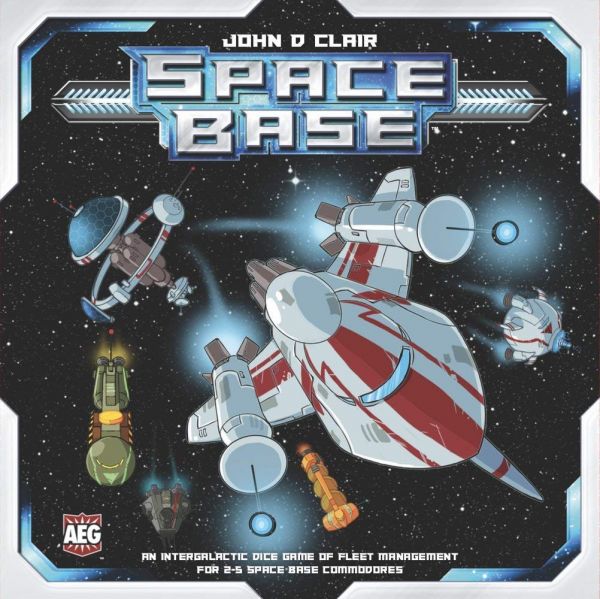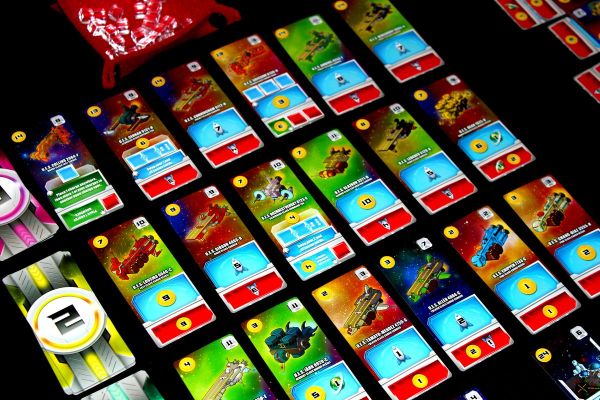Create an Efficient Colony of Ships and Race to Be the Most Influential in Space Base

Space Base is a 2-5 player race to gain the most victory points for your particular space base. Sounds simple enough, right?
Gameplay
Each player begins with their individual board (representing their unique space base) and twelve starter ships (numbered 1-12) to represent the potential rewards to be earned by the roll of two die. Players take turns rolling their dice, with each roller earning the rewards (credits, income, and/or influence, which are marked on each player’s board) specified by each ship placed on their board.
Yet, there is more nuance to Space Base than a simple roll-and-collect mechanism. As players begin to accrue credits, they can buy Level 1, 2, and 3 ships (with the cost of available ships rising with each level) for a shared tableau of available cards. The higher the level of the ship, the better rewards it offers. As players buy new ships for a designated total, they will flip over their existing ships. Each ship has a blue and red rectangle. The blue rectangle alerts players to the benefit they receive when it’s their turn to roll the dice, while the red rectangle lets players activate that reward during other players’ rolls.
Therein lies the real strategy of Space Base. While there are tangible benefits in building your board toward great rewards when you are the player rolling the die, there’s an even bigger benefit to loading up each of your spaces with flipped over cards that allow you to take advantage of others’ turns.
This is not the only manner in which dice are leveraged to your benefit, as players can choose to use the cumulative total of the die or use the individual roll on each die. For example, a player rolling a 3 and a 5 can use those die to either activate the rewards of the 3 and 5 ships on their boards, or the 8 ship. The other players have those same options with any of their flipped cards in those same areas (if they have red benefits turned over for those specific areas on their own board).
At the heart of Space Base is a race — the race to be the first to 40 influence, which act as the game’s victory points. How you build your engine of spaceships to accomplish this is variable. The Levels 1-3 ships offer better rewards than your starting ships, and ensuring that you continually buy new ships and create a tableau of rewards activated by other players’ rolls is key. However, neglecting to make your own rolls rewarding can leave you in the dust if you’re not careful. Some ships offer special abilities that must be charged to use, but unleashing those abilities at the most opportune time may swing a game in your favor and set off a chain of income increases, credits, and victory points. There are also unique colony cards (one for each numbered dock on the player boards) that give a one-time influence bump, but purchasing these colonies excludes a player from buying ships for that numbered space.

Photo by kalchio on BoardGameGeek.com
Review
The paths to victory in Space Base are many, which creates a new and exciting experience each time the game is played. Similar to games in this model (Splendor, Century: Spice Road, and of course, Machi Koro), the ability to create combinations across your tableau is key. Unlike games with a similar feel, Space Base requires you balance your income, credits, and influence gains. As you increase your income, your starting capital increases for each turn. If you save up a lot of credits only to find another player has bought the ship or colony you were eyeing, you may find yourself settling for another card and losing all your credits (no matter the cost of a ship or colony, all credits are spent if a purchase is made).
There’s also the balance between flipping over ships to gain the red benefits from other players’ turns, while also ensuring one’s own space base has great blue benefits. Though most of a player’s increases will likely come from other players rolling the die, there are ships that specifically lend themselves to being better by remaining unflipped. Therefore, plotting and planning which cards you buy (and in what order) is key, especially in a 4-5 player game.
Space Base is not without its flaws. Two player games become a straight race toward 40 influence, with little heed having to be paid to large income and credit gains. There is more emphasis in filling one’s space base with as many red benefits across all dice totals rather than focusing on a balance between red and blue benefits. Also, ships that have special abilities do not feel worth the investment in a two player game, whereas they feel very potent and game-changing (but not overpowered) in 3-5 player games.
Yet Space Base, even in two player race scenarios, is a lot of fun — and a clear step above games using similar mechanics. Even for players who feel they are terrible at dice rolling games, Space Base provides the chance to rely on other players’ good rolling for one’s own benefit. It’s very rare a game that can make an opponent's turn just as thrilling (and if you’ve built your tableau of ships well, more so) as their own turn.
Pros: Varied engine building techniques, benefits from other players’ rolls
Cons: Two player games are not as nuanced as 3-5 player games







